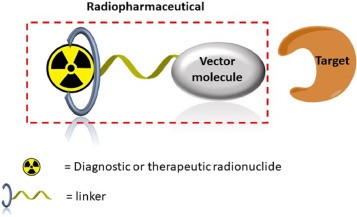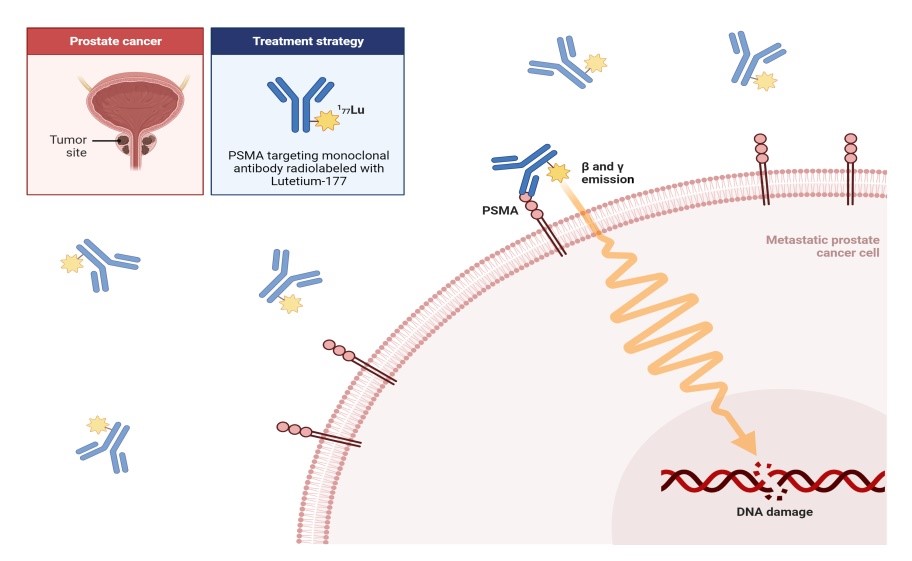The discovery of artificial radioactivity triggered the birth of nuclear medicine which is a peculiar medical specialty able to depict pathophysiological processes in the human body by using radiopharmaceuticals. Thus radiolabelling and radio imaging play a crucial role in disease management. The choice of a particular radionuclide is very important in radiopharmaceutical. New researchers are very much used to these techniques for getting accurate results and going for better exposure in their research.
Keywords: Radiopharmaceutical, Radio imaging, Radiolabelling, Radionuclide, Disease management.
Introduction
A radiopharmaceutical is a radioactive compound used for the diagnosis and treatment of human diseases. In nuclear medicine, nearly 95% of the radiopharmaceuticals are used for diagnostic purposes, while the rest are used for treatment. It is a relatively new modality to develop a new way for cell biology, and molecular biology is also the new definition for diagnostic imaging. Radiolabelling and imaging are making light on the pharmaceutical field just because the substance has a particular mechanism of localisation for the foreign particles and no need for the complicated structural requirements. These advantages of radio compounds minimise the requirement for biological, physiological, and immunological purposes. On the other hand, some researchers used the compound for the in vitro study by using radio compounds for better control of the biological and immune logical matter. Most of the radiolabelled compounds and polymers were subsequently tested in vivo to explore which systems can ultimately serve as which imaging modality in personalised/individualised best therapy approaches [1]. Recently many studies have shown that the radio labelling of nanoparticles has potential use as a drug delivery system. Radiopharmaceuticals generally consist of two components, a radioactive element (radionuclide), that permits external scan, linked to a non-radioactive element, a biologically active molecule, drug or cell (red and white blood cells labelled with a radionuclide, for example) that acts as a carrier or ligand, responsible for conducting the radionuclide to a specific organ.

Figure: Targeted Radiolabelled approach
Methods of radiolabelling: Radiolabelling techniques start with selecting the proper radionuclides by knowing the proper target. The very next step is to select the labelling for the compound. majorly in the pharmaceutical industry, there are 3 major ways for labelling the compound. I) Direct labelling, ii) Pre labelling, and iii) Post labelling
I. Direct labelling
This direct labelling is the simplest and fastest-used method for labelling drug in the pharmaceutical industry. These techniques are running by changing a few functional groups & bonds in the main structure of the drug. On the other hand, we can go for the simple modification in radionuclide to get a better result. Hence the main purpose of changing the functional group in the drug or the radionuclides is to get a stable and efficient radiopharmaceutical. One example of radiolabelling is the labelling of 99mTc with protein [2]. In this type of radionuclide, stannous reduces its oxidation state and this modification led to radiolabelling of protein. Most of the researchers use these techniques for labelling the compounds.
II. Pre – labelling approach
There are a few cases where the direct labelling approach was unsuitable for the product. For this type of compound, the approach we going for is the pre-labelling approach. The principle of this type of approach involves the utilisation of another agent that acts as a mediator between the radionuclide and the biomolecule. The mediator is called a Bifunctional Chelating agent. Next, the BFCA conjugate with the drug and makes the labelling happen. There is a wide variety of molecules that do not have a direct approach procedure.
III. Post-Labelling Approach
In this approach the BFCA first conjugates with a biomolecule/drug of interest to form a BFCA-biomolecule/drug conjugate. This conjugate is then directly radiolabelled with a radionuclide of interest. A few other approaches are there to label the pharmaceutical product like biosynthesis, excitation labelling, and recoil labelling.
Radio imaging
Radio imaging helps in radiopharmaceuticals for the use of low levels of radiotracers. Currently, this imaging technique is used to detect diseases, monitor the proper treatments, and analyse the proper tissue physiology. Radionuclides are used in diagnostic imaging, but the activity shown in modern medical fields is limited. It is used in imaging the thyroid glands, lacrimal glands, pulmonary perfusion, bones etc. The techniques are used for most common diseases. There are some nuclides used in imaging are I123, I131, Selenium75, Na22, and Xe133.
The detection of radio imaging occurs by detecting the emitted radiation from the radioisotopes. The process itself is called scintigraphy.
Application of radiolabelling in radiopharmaceuticals
Some basic applications in the pharmaceutical field of the radiolabelled compound are to diagnose any physiological alteration in our body and systematically help the nuclides for the drug to act on the side of action. There are different kinds of radionuclides present in the radiopharmaceutical industry, applications are like each other but the uses of the products are different depending upon their nature of radiation and mode of action on living organisms. The functionality of the radio substances is also worked on the different parts of the body. Like: Technetium-99 m is Used for diagnosing cardiac amyloidosis. Chromium-51 is Used in the diagnosis of pernicious anaemia. Fluorine-18 is Used in positron emission tomography to assess alternations in glucose metabolism in the brain and cancer. Holmium-166 is Used in the diagnosis of liver cancer. Iodine-125 is Used in the diagnosis and evaluation of the glomerular filtration rate of kidneys. Gallium-67 is Used in tumour imaging. Potassium-42 is Used in the determination of exchangeable potassium in coronary blood flow. Rubidium-86 is Used in the determination of myocardial blood flow. Iodine-131 is Used in studying the function of the thyroid gland and its physiological parameters. Selenium-75 is Used to study the production of digestive enzymes. Sodium-24 is Used to study sodium exchange in the bloodstream. Xenon-133 - Used to study pulmonary ventilation and its alteration. Thallium-201 - Used to diagnose coronary artery disease, death of heart muscle, and many heart diseases [3].

Figure: Radiolabeling for Prostate Cancer targeting
Significance
In the modern-day healthcare system, the role of radiopharmaceuticals is major. Many countries use these techniques for developing nuclear medicines. These techniques are useful in the treatment of many malignancies and tumour-like diseases. But designing the product in the radiopharmaceutical industry is complicated and the procedures rely on many factors. selecting the proper nuclide is critical, and challenging because every specific nuclide has a specific half-life and specific targeting activity based on the nature of their radioactivity. Some other factors are there like stability, handling, and cost of the product impact the utility of radiopharmaceuticals [4]. Medical doctors and chemists have identified a large number of chemicals that are absorbed by specific organs. The thyroid, for example, absorbs iodine while the brain absorbs glucose. Diagnostic radiopharmaceuticals can be used to monitor blood flow to the brain, liver, lung, heart, and kidney. Particulate radiation can be useful for destroying or weakening cancer cells (radiotherapy) [5]. The radionuclide that generates the radiation can be located in a certain organ in the same way used for diagnostics. In many cases, beta radiation destroys cancer cells. 177Lutetium (177Lu), for example, is prepared from 176ytterbium (176Yb) which is irradiated to transform it into 177Yb, which rapidly returns to 177Lu. 90Yttrium (90Y) is used to treat cancer, especially non-Hodgkin’s lymphoma and liver cancer. 131Iodine (131I), 153samarium (153Sm) and 32phosphorus (32P) are also used in radiotherapy. 131Cesium (131Cs), 103palladium (103Pd) and 223radium (223Ra) are used in special cases. Radiopharmaceuticals should be prepared according to the instructions of the manufacturer [6].
Conclusion
The choice of radionuclide depends not only on the type of study, but also on molecular properties such as biological half-life, hydrodynamic radius, molecular surface charge, or target binding. Labelling and imaging in radiopharmaceuticals play a pivotal role in clinical research through the accuracy of targeted therapy and precise imaging. The importance of modern medicines has some beneficial roles in the treatment of various diseases. The labelling of the product has led to a better understanding of the biological processes and led to a new drug therapy and by radio imaging we can accurately go for the diagnosis of any disease. Although these modern techniques have some safety and regulatory issues, they ensure the use of the product for safe use and develop new paths for new medical advances. Radiopharmaceuticals are radioisotopes bound to biological molecules able to target specific organs, tissues or cells within the human body. These radioactive drugs can be used for the diagnosis and, increasingly, for the therapy of diseases.
References